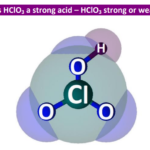Is acetic acid (CH3COOH) an acid or base? Weak or Strong - Conjugate base
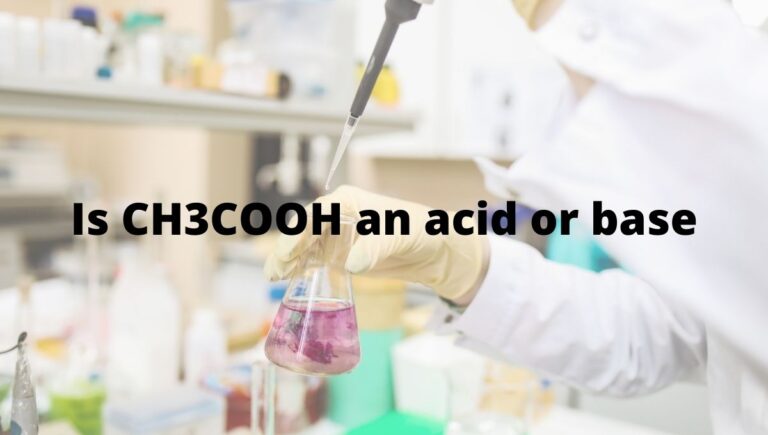
Acetic acid appears as the colorless liquid is a monocarboxylic acid that contains two carbon with the chemical formula C2H4O2 or CH3COOH. It has a strong odor of vinegar and a molar mass of 60.052 g·mol−1. Acetic acid is used as a solvent for the production of other chemical compounds like cellulose acetate, polyvinyl acetate, etc.
In this article, we will discuss Is Acetic (CH3COOH) an acid or base? Is it strong or weak in nature? Its conjugate acid-base pairs, etc.
So, Is CH3COOH an acid or base? CH3COOH is a weak acid. Because when it is dissolved in water, it does not ionize completely to release H+ ions. Therefore, the aqueous solution of CH3COOH contains fewer hydrogen ions which ultimately makes, it a weak acid.
| Name of Molecule | Acetic acid |
| Chemical formula | CH3COOH |
| Nature | Weak acid |
| Conjugate base | CH3COO– |
| Acidity (pKa) | 4.75 |
Why CH3COOH is acid?
An acid is a substance that liberates an H+ ion or proton when dissolved in water and has a pH value from 1 to 6.
So, CH3COOH is considered an acid. When it is dissolved in an aqueous solution, it dissociates into two parts (CH3COO– and H+), the presence of H+ ion in the aqueous solution of CH3COOH makes it acid in nature.
⇒ CH3COOH ⇌ H+ + CH3COO−
To understand whether CH3COOH is an acid or base, look out the two important theories of the acid-base concept (a). Arrhenius theory (b). Bronsted-Lowry theory
1. Arrhenius theory for acid:
According to Arrhenius’s theory for acid, the substance which produces an H+ ion or proton on dissolving in an aqueous solution is categorized as an acid. So, when CH3COOH is dissolved in an aqueous solution then it produces some H+ ion or proton in the solution.
Therefore, we can say CH3COOH is acid as per Arrhenius’s theory of acid-base pair.
2. Bronsted-Lowry theory for acid:
According to Bronsted-Lowry’s theory for acid, the substance which donates the proton to other compounds and itself makes a conjugate base categorized as an acid. So, when CH3COOH reacted with water, it donates the proton or H+ ion and itself makes a conjugate base(CH3COO–).

As you see in the above reaction, CH3COOH liberates or donates the one H+ ion to the water molecule and itself makes a conjugate base (CH3COO–). The final aqueous solution of CH3COOH contains H3O+ ions and a conjugate base(CH3COO–).
Therefore, we can say, in the above reaction, CH3COOH acts as Bronsted-Lowry acid because of proton donating ability, and H2O acts as a Bronsted-Lowry base because of proton accepting ability.
Note:- Bronsted-Lowry theory is not limited to an aqueous solution, this theory state that a substance is said to be Bronsted-Lowry acid when it donates the proton to other reacting species, the reacting species should be base or very less acidic in nature because according to this theory-
A substance can function as an Bronsted-Lowry acid only in the presence of a base. i.e. OH–, NaOH, NH3, H2O, etc.
But Arrhenius’s theory said a substance is an acid when it loses the proton on dissolving in an aqueous solution. The presence of water solution is a must for knowing the acidic nature of substance according to Arrhenius theory.
Is CH3COOH (Acetic acid) strong or weak?
For knowing whether acetic acid is strong or weak, look out the basic difference between a strong acid and weak acid-
A strong acid is a compound that is 100% ionized or completely dissociates in a solution and gives a high amount of hydrogen ions. It means all the moles of acid will dissociate to give H+ ions and no undissociated acid remains in the solution. They have a low pH value and good electrical conductivity properties.
Examples of strong acids: Hydrochloric acid(HCl), Sulfuric acid(H2SO4), Nitric acid(HNO3), HBr, HI, etc.
Also Read:-
- Why H2SO4 is a strong acid?
- Why HNO3 is a strong acid?
- Why HCl is a strong acid?
- Why HBr is a strong acid?
- Why HI is a strong acid?
And weak acid is a compound that partially dissociates which means not all moles of weak acid dissociate in a solution to give H+ ion or they are not 100 % ionized in a solution and give only a low amount of hydrogen ions. They have a high pKa or pH value with moderate electrical conductivity property and weak electrolyte compare to strong acid.
Examples of a weak acid – Hydrogen cyanide(HCN), Ammonium ion(NH4+), Phosphoric acid(H3PO4), HF, HCOOH, H2CO3, etc.
Also Read:
- Why NH4+ is a weak acid?
- Why HCN is a weak acid?
- Why HF is a weak acid?
- Why HCOOH is a weak acid?
- Why H2CO3 is a weak acid?
- Why H3PO4 is a weak acid?
| Strong acid | Weak acid |
| They ionize completely. | They do not completely ionize. |
| They have high conductivity. | They have less conductivity. |
| The value of pH lies between 0 to 3. | The value of pH lies between 3 to 7. |
| They dissociate completely to produce an H+ ion. | They dissociate partially to produce an H+ ion. |
| They are strong electrolytes. | They are weak electrolytes compare to strong acids. |
| Example – HCl, HNO3, HBr, etc. | Example – HNO2, HCOOH, CH3COOH, etc. |
Now, Is acetic acid (CH3COOH) strong or weak? Acetic acid(CH3COOH) is a weak acid because it partially dissociates in an aqueous solution or it does not ionize completely in solution to produce H+ ions. The strength of an acid depends on its ability to ionize completely or partially in a solution.
So, all molecules of acetic acid not ionized completely cause fewer hydrogen ions in the aqueous solution and we know the more the hydrogen ion present in the solution, the higher will be the acidic strength of that solution.
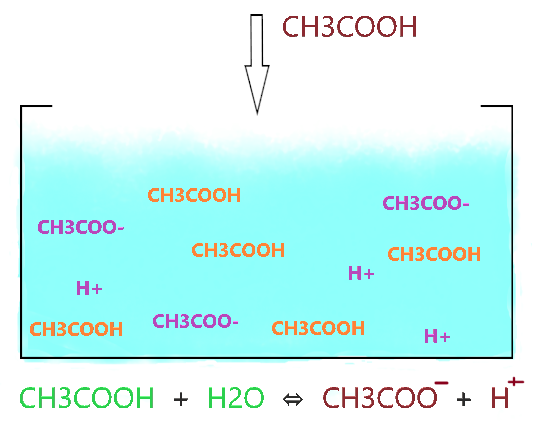
As shown in the figure, when CH3COOH is dissolved in water, it dissociates into two ions (CH3COO– and H+) but the ion(CH3COO–) is not stable in ionic form, it wants to combine with H+ and make CH3COOH again.
So, not all the CH3COOH molecules dissociate, most of them stay together and only a few of them dissociate and liberate H+ ions. And those CH3COOH dissociate into ions, their most of the split ions(CH3COO– and H+) reform with each other and again forms the CH3COOH molecule.
Also, the double arrow in the reaction of acetic acid and water shows that both forward and backward reactions occur at equilibrium.
The acid dissociation constant value for acetic acid is 1.8 × 10-5 and anything less than 1 value of the acid dissociation constant for the molecule shows its weakly acidic nature.
Note:- In weak acid, the backward is more dominating than forwarding reaction, as the splitting ions easily react with each other to reform the acid molecule.
More reasons Why CH3COOH is a weak acid?

In acetic acid structure, a CH3 group is present which is also called the electron-donating group, this CH3 donates the electron or you can say it contributes the electron towards the O-H group, this increases the electron density on the oxygen atom attached to hydrogen.
Now oxygen has more electron density, so it is unable to pull the electrons from the hydrogen atom, hence the ionization of the O-H bond difficult.
Or you can say the electron-donating group(CH3) decreases the polarity of the O-H bond, hence, the removal of hydrogen becomes more difficult in water solution.
Therefore, the less hydrogen present in the aqueous solution of CH3COOH, makes it weak acid in nature.
Note:– More is the polarity, high is the acidic strength because polar bonds dissociate more easily in water solution, hence it is easier for the proton to leave the molecule.
Here’s the list of some common acids and bases with their strength.

Why CH3COOH is not a base?
A base is a substance that accepts the proton from other compounds or releases OH– ion in an aqueous solution. The strength of basicity in an aqueous solution depends on the number of OH– ions in the solution.
So, CH3COOH is not a base because when it is dissolved in water, it produces an H+ ion instead of an OH– ion. Also, CH3COOH is a proton donor which is also against the property of the base.
⇒ CH3COOH + (aq) → H+ (aq) + CH3COO– (aq)
Here’s what Arrhenius and Bronsted-Lowry said for base compound-
Arrhenius theory for base:
According to the Arrhenius theory for the base, the substance which produces an OH– ion on dissolving in an aqueous solution is categorized as a base. CH3COOH doesn’t liberate any OH– ion when dissolved in water, so it does not fall into the category of Arrhenius bases.
Bronsted-Lowry theory for base:
According to the Bronsted-Lowry theory for the base, the substance which accepts the proton to other compounds and itself makes a conjugate acid categorized as a base. So, when CH3COOH reacts with the weater molecule, it donates the proton to the water molecule and itself makes a conjugate base.
Therefore, CH3COOH also does not fall into the category of Bronsted-Lowry bases when reacting with the compounds such as H2O.

Also Check:- How to know if something is acid or base?
What is the Conjugate base of CH3COOH
When one proton loses from acid then a compound is formed which is called the conjugate base of that acid, similarly when one proton is added to the base then a compound is formed which is called conjugate acid of that base. In technical terms, Compounds differentiated from each other by a single proton(H+) are said to be Conjugate acid-base pairs.
The concept of conjugate acid-base pair.
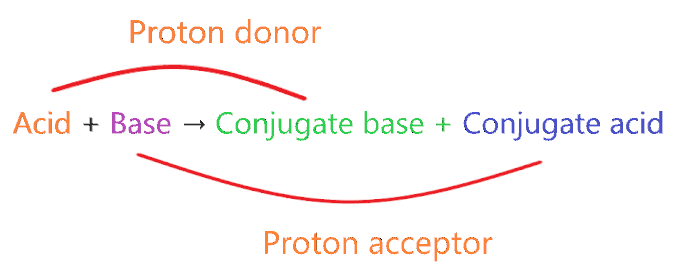
- A very strong acid always forms a weak conjugate base.
- A very strong base always forms a weak conjugate acid.
- A very weak acid always forms a strong conjugate base.
- A very weak base always forms a strong conjugate acid.
So, CH3COOH is a weak acid that forms a conjugate base according to the concept of conjugate acid-base pair.
The conjugate base of CH3COOH is Acetate(CH3COO-).
Acetate is a monocarboxylic acid anion resulting from the removal of a proton from the carboxy group of acetic acid.
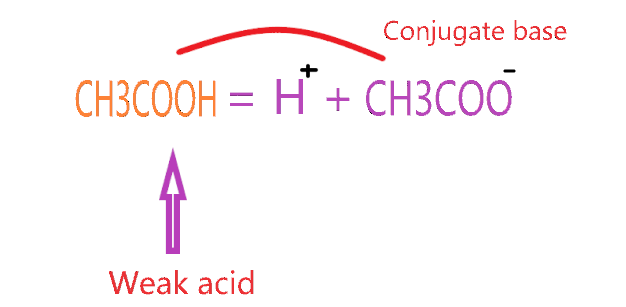
Why CH3COOH is a monoprotic acid?
There are three terms we frequently encounter in the acid-base concept – (a). monoprotic acid (b). diprotic acid (c). triprotic acid.
(a). Monoprotic acid
The acid produces or liberates only one hydrogen ion per mole when they ionized in an aqueous solution called monoprotic acid. Example – HCl, HNO3, etc.
⇒ HCl → H+ + Cl–
(b). Diprotic acid
The acid produces or liberates only two hydrogen ions per mole when they are ionized in an aqueous solution called diprotic acid. Example – H2SO4.
⇒ H2SO4 → 2H+ + SO4 – –
(c). Triprotic acid
The acid produces or liberates three hydrogen ions per mole when they are ionized in an aqueous solution called tricrotic acid. Example – H3PO4.
⇒ H3PO4 ⇌ 3H+ + PO4−
So, Acetic acid is a monoprotic acid because when one mole of it is dissolved or ionized in water, it produces only one hydrogen ion.
⇒ CH3COOH ⇌ H+ + CH3COO−
Why HCl is a stronger acid than CH3COOH?
As we discussed, a strong acid is a compound that is 100% ionized or dissociates in an aqueous solution and gives a high amount of hydrogen ion.
So, HCl is a strong acid because it dissociates completely in an aqueous solution to produces H+ ions, which means no parts of HCl acid remain undissociated in the solution.
⇒ HCl → H+ + Cl–
The single arrow shows in the above reaction that splitting ions(H+ and Cl–) are not able to reforms again to produce HCl molecule in water solution.
CH3COOH is weak acid compare to HCl because it doesn’t dissociate completely in an aqueous solution to liberate H+ ions, which means some parts of CH3COOH acid remain undissociated in the solution.
⇒ CH3COOH ⇌ H+ + CH3COO−
The double arrow shows in the above reaction that splitting ions again reform with each other to form the CH3COOH acid again in a water solution.
Note: In HCl, more hydrogen ions are produced due to complete ionization whereas in CH3COOH fewer hydrogen ions are produced due to only partial dissociation.
Preparation of acetic acid
Acetic acid is mainly produced by the methanol carbonylation method. The three-step process involved in this method-
- CH3OH(methanol) + HI → CH3I(methyl iodide intermediate) + H2O
- CH3I(methyl iodide intermediate) + CO → CH3COI(acetyl iodide)
- CH3COI(acetyl iodide) + H2O → CH3COOH(acetic acid) + HI
A mixture of carbon dioxide and hydrogen produces acetic acid-
⇒ 2 CO2 + 4 H2 → CH3COOH + 2 H2O
Species of anaerobic bacteria used to convert sugars to acetic acid-
⇒ C6H12O6 → 3 CH3COOH
Ethanol with oxygen used to produce acetic acid-
⇒ C2H5OH + O2 → CH3COOH + H2O
With the help of acetaldehyde oxidation-
⇒ 2 C4H10 + 5 O2 → 4 CH3COOH + 2 H2O
Properties of acetic acid
- Acetic acid is a colorless liquid with a pungent smell.
- It has a boiling point of 119 °C and a melting point of 17 °C.
- Acetic acid is miscible in water.
- The acid dissociation constant value of CH3COOH in an aqueous solution is 4.76.
- It is a polar compound and a dipole moment of 1.74 D.
Uses of acetic acid
- Acetic acid majorly uses for the production of vinyl acetate monomers.
- Industrially, acetic acid is used in the preparation of metal acetate.
- It is used for the manufactures of various rubber and perfumes.
- Acetic acid is used in the production of rayon fiber.
- It is used in making photographic films and textiles.
Conclusion
Acetic acid has an odor of vinegar with molas mass 60.052 g·mol−1. The main use of acetic acid is to produce vinyl acetate monomer. It is soluble in water and a dipole moment of 1.74 D. The pKa(acid dissociation constant) value of acetic acid is 4.76.
- Is CH3COOH an acid or base? CH3COOH is an acid. It has a proton or hydrogen ion to donate in an aqueous solution.
- CH3COOH is acting as an Arrhenius acid and Bronsted-Lowry acid.
- The conjugate base of Acetic acid (CH3COOH) is Acetate (CH3COO–).
- Acetic acid is a monoprotic acid because when one mole of it is dissolved in water, it produces only one hydrogen ion.
- Is CH3COOH (acetic acid) strong or weak? Acetic acid is a weak acid. Because it contains fewer hydrogen ions in the aqueous solution as it only dissociates partially or not 100% ionized when dissolved in water.
About the author
Vishal Goyal is the founder of Topblogtenz, a comprehensive resource for students seeking guidance and support in their chemistry studies. He holds a degree in B.Tech (Chemical Engineering) and has four years of experience as a chemistry tutor. The team at Topblogtenz includes experts like experienced researchers, professors, and educators, with the goal of making complex subjects like chemistry accessible and understandable for all. A passion for sharing knowledge and a love for chemistry and science drives the team behind the website. Let's connect through LinkedIn: https://www.linkedin.com/in/vishal-goyal-2926a122b/

